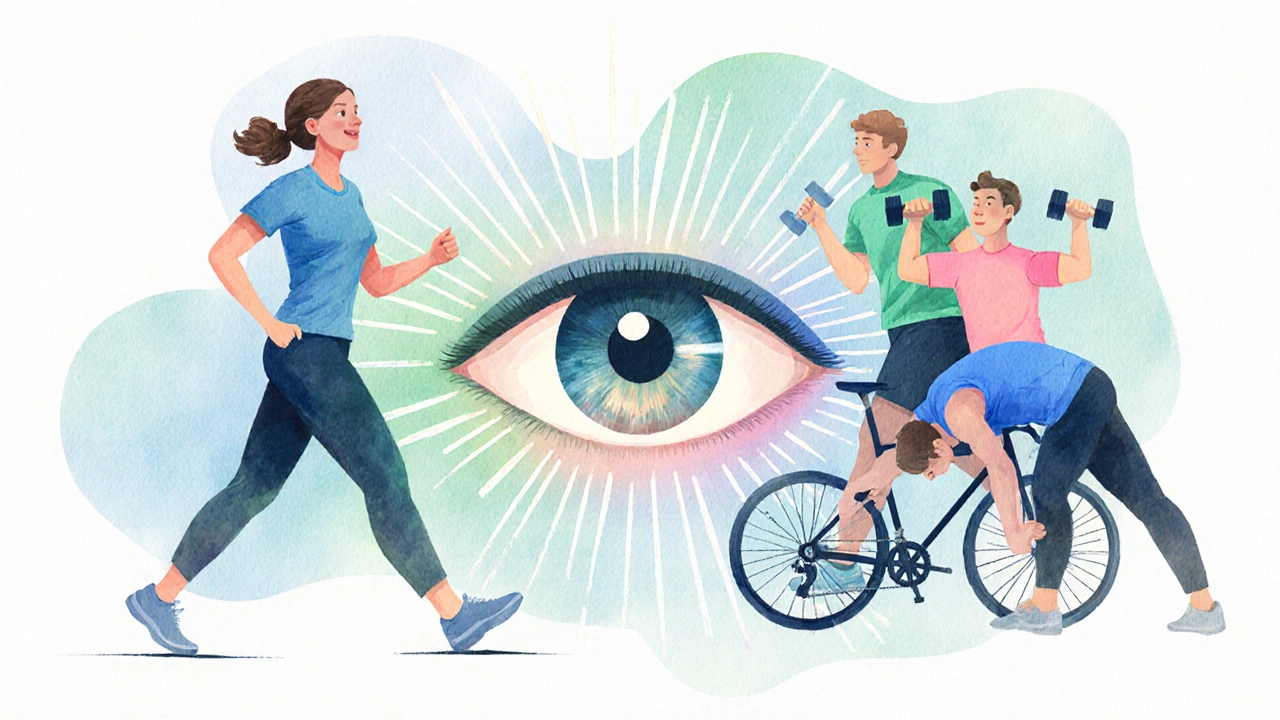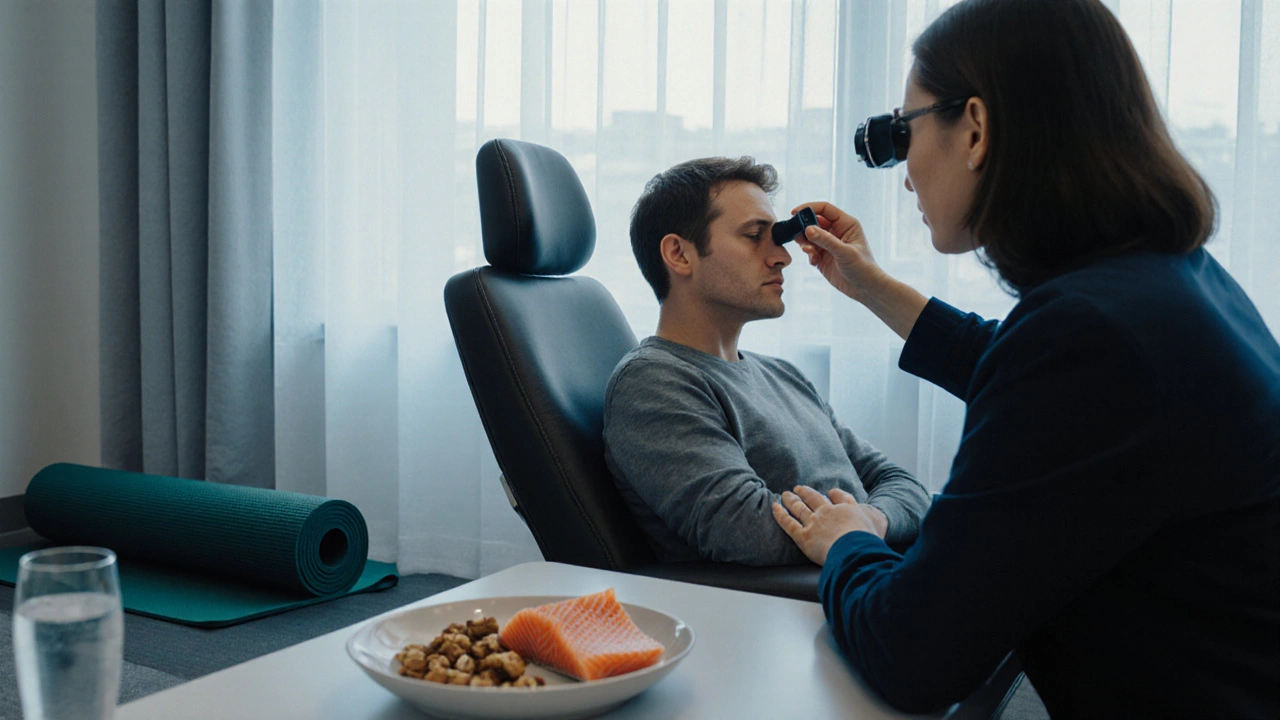
Ocular Hypertension Exercise Calculator
Calculate Your IOP Reduction
Estimated IOP After Exercise
Key Takeaways
- Regular aerobic activity can drop intraocular pressure (IOP) by 2‑4 mmHg.
- Both moderate‑intensity cardio and resistance training improve ocular blood flow.
- Consistent exercise reduces the risk of progressing from ocular hypertension to glaucoma.
- Start with 150 minutes of moderate activity per week; add eye‑specific stretches for extra benefit.
- Consult an optometrist before beginning a new routine if you have eye‑related conditions.
When doctors talk about ocular hypertension is a condition where the pressure inside the eye is higher than normal but without clear signs of optic‑nerve damage, the first question is often “Can lifestyle changes help?” The short answer is yes-exercise is one of the most proven non‑pharmacologic tools. Below we break down why moving your body matters for eye health, which workouts give the biggest boost, and how to build a safe routine.
Why Exercise Matters for Eye Pressure
Every heartbeat sends a pulse of blood through the tiny vessels that nourish the retina and the optic nerve. When you engage in physical activity any bodily movement that raises heart rate and energy expenditure, two key things happen:
- Improved cardiovascular health lowers systemic blood pressure, which in turn eases the pressure gradient across the eye’s drainage system.
- Increased blood flow the movement of oxygen‑rich blood through capillaries to the choroid enhances the function of the trabecular meshwork, the eye’s natural drainage channel.
Studies from the American Academy of Ophthalmology (2023) show that participants who logged at least 150 minutes of moderate exercise each week experienced an average IOP reduction of 2.3 mmHg compared with sedentary controls. Even a modest drop can shift someone from a high‑risk to a low‑risk category for glaucoma development.

What the Numbers Say
Intraocular pressure, measured in millimeters of mercury (mmHg), typically ranges from 10 to 21 mmHg. Ocular hypertension is defined as a consistent reading above 21 mmHg without optic‑nerve damage. Below is a snapshot of research findings:
- 30‑minute brisk walk: ‑1.8 mmHg after 1‑hour post‑exercise.
- 30‑minute cycling at 60% VO₂max: ‑2.5 mmHg sustained for up to 3hours.
- Resistance training (3 sets of 10 reps, moderate load): ‑1.2 mmHg immediately after session.
These changes are temporary but repeatable. Over weeks of consistent activity, baseline IOP often stabilizes at a lower level, giving the eye a buffer against spikes that could damage the optic nerve.
Types of Exercise and Their Impact
| Exercise Type | Intensity | Average IOP Drop (mmHg) | Notes |
|---|---|---|---|
| Aerobic (brisk walking, jogging) | Moderate (40‑60% VO₂max) | 1.8‑2.5 | Best for sustained pressure reduction; easy to maintain daily. |
| High‑Intensity Interval Training (HIIT) | High (80‑90% VO₂max bursts) | 2.0‑3.0 | Shorter sessions, but requires warm‑up to avoid sudden IOP spikes. |
| Resistance (weight machines, free weights) | Moderate‑Heavy | 1.0‑1.5 | Improves muscle tone around the eye; avoid Valsalva maneuver. |
| Yoga (inversions excluded) | Low‑Moderate | 0.5‑1.0 | Promotes relaxation; head‑down poses can temporarily raise IOP. |
Takeaway: Aerobic cardio gives the biggest consistent drop, while resistance work adds strength that supports eye‑muscle health. Yoga can be a calming adjunct, just skip the head‑stands.
Building a Safe Exercise Routine
Start with the guidelines from the World Health Organization: at least 150minutes of moderate activity or 75minutes of vigorous activity per week. Here’s a practical week‑long plan that targets eye pressure without overdoing it.
- Monday - 30min brisk walk: Keep a pace where you can talk but not sing.
- Tuesday - 20min body‑weight circuit: Squats, lunges, push‑ups (3sets×10reps). Remember to breathe out during exertion to avoid Valsalva.
- Wednesday - Rest or gentle stretching: Include eye‑relaxation moves (palming, eye rolls).
- Thursday - 30min cycling: Maintain steady cadence; aim for 60‑70rpm.
- Friday - 15min HIIT: 30sec sprint, 90sec walk, repeat 6 times.
- Saturday - Light yoga: Focus on forward bends, avoid inversions.
- Sunday - Free choice: Any activity you enjoy; consistency beats intensity.
Track your IOP with a home tonometer if your doctor approves, or schedule monthly checks at the clinic. Seeing a downward trend reinforces the habit.

Who Should Be Cautious
Most people with ocular hypertension can safely start a low‑to‑moderate program, but a few groups need extra care:
- Patients on certain glaucoma meds like prostaglandin analogues that can affect blood flow may experience exaggerated IOP drops; monitor symptoms.
- Those with cardiovascular disease should get clearance before high‑intensity workouts.
- Anyone who feels eye discomfort, blurred vision, or sudden headache during exercise should stop and seek professional advice.
Consult an optometrist eye care professional who can measure IOP and assess optic‑nerve health before making major changes.
Beyond Exercise: Lifestyle Tips that Complement Eye Health
Exercise works best when paired with other habits:
- Hydration: Dehydration can concentrate aqueous humor, marginally raising pressure.
- Balanced diet: Foods rich in omega‑3 fatty acids (salmon, walnuts) support vascular health.
- Avoid smoking: Tobacco narrows blood vessels, reducing ocular perfusion.
- Manage stress: Chronic stress spikes cortisol, which may affect IOP.
Think of eye health as a team sport-exercise is the star player, but the rest of the roster matters too.
Frequently Asked Questions
Can a single workout lower my eye pressure permanently?
A single session typically produces a temporary drop that lasts a few hours. Permanent reduction comes from repeated activity over weeks or months, allowing the eye’s drainage system to adapt.
Should I avoid high‑intensity workouts because they raise blood pressure?
High‑intensity work can cause a brief spike in IOP during the effort, but research shows the post‑exercise drop outweighs that spike if you include a proper cool‑down. Always breathe out during exertion and avoid holding your breath.
Is yoga safe for ocular hypertension?
Gentle yoga improves circulation and reduces stress, which are both beneficial. Skip inversions (head‑stands, shoulder stands) because they temporarily raise pressure.
Do I need special eye‑specific exercises?
Eye‑muscle stretches (palming, focusing on a distant object) help relieve eye strain but don’t directly lower IOP. They’re a good complement to cardio and resistance work.
How often should I get my IOP checked if I’m exercising?
If you’re newly active, schedule a baseline exam, then follow up every six months. Your eye doctor can track trends and adjust any medication if needed.
Bottom line: Moving your body isn’t just good for the heart-it’s a powerful tool for keeping eye pressure in check and slowing the march toward glaucoma. Start with a realistic routine, stay consistent, and let your eyes reap the reward.




14 Comments
Exercise, when performed with intentionality, initiates a cascade of physiological events that culminate in the reduction of intra‑ocular pressure; this is not merely anecdotal, but supported by peer‑reviewed studies. The act of aerobic activity elevates systemic blood flow, thereby enhancing aqueous humor outflow via the trabecular meshwork; consequently, pressure diminishes. Moreover, the sympathetic nervous system modulation during moderate‑intensity workouts induces a temporary vasoconstriction that facilitates fluid drainage from the anterior chamber. Researchers have documented that a brisk 30‑minute walk can lower IOP by up to 2.5 mmHg, an effect that persists for several hours post‑exercise. High‑intensity interval training amplifies this phenomenon, as repeated bursts of activity stimulate ocular perfusion pressure fluctuations, encouraging the eye’s natural filtration mechanisms. Resistance training, while primarily targeting muscular hypertrophy, also contributes by improving overall vascular health, which indirectly benefits ocular fluid dynamics. Yoga, even in its non‑inverted forms, promotes relaxation and reduces systemic stress hormones; these hormonal shifts can subtly influence IOP, often yielding reductions of 0.5–1 mmHg. It is essential to recognize that consistency outweighs intensity; a regular regimen of varied exercises yields cumulative benefits that surpass sporadic high‑impact sessions. Importantly, individuals with pre‑existing ocular conditions should consult their ophthalmologist before initiating any new exercise protocol, to tailor activities to their specific needs. The calculator presented in the article provides a valuable tool for estimating potential IOP changes, yet it remains an approximation; real‑world outcomes may vary based on genetics, baseline pressure, and adherence to the exercise plan. Ultimately, integrating physical activity into daily life serves a dual purpose: safeguarding vision while enhancing overall cardiovascular health, a win‑win scenario for the body and the eyes alike.
A quick walk can be a game changer for eye pressure-keep moving!
I’ve noticed a subtle drop after my morning jog, which feels reassuring.
Oh, brilliant, because we all have time to sprint until we’re out of breath-thanks for the groundbreaking insight.
Aerobic workouts shave a couple of mmHg off IOP.
Yo, just tried the HIIT routine-felt wild, but yeah, my eye docs say it’s legit. Keep at it, and you’ll see the pressure dip, trust me!
A trivial pursuit, really.
I appreciate the calm tone of the calculator; it feels like a quiet guide.
Keep up the good work, friends! 😊 Exercise is a win for the eyes.
Wow, who knew jogging could be the secret sauce for crystal‑clear vision? #MindBlown
Really nice you included yoga it's gentle and still helps a bit
Do you truly grasp the gravity of intra‑ocular pressure, or merely skim the surface of ocular health? One must confront the abyss!
Absolutely! The data is compelling, and the calculator makes it so accessible!!! 🎉
They don’t want you to know that the pharma giants push pills while hiding the simple truth: a daily jog lowers pressure and cuts their profit margins.